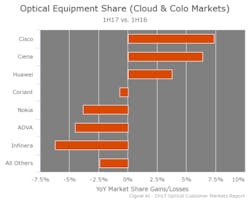Cloud and colo optical spending takes a 1H17 dive: Cignal AI
Optical module vendors may still rely on the cloud, colocation, and related data center market for revenue strength say some (for example, "Data center appetite for 100GbE optical transceivers increasing: Lightcounting"), but systems houses have had a different experience so far in 2017, says Cignal AI. The money such customers spent on optical transport systems declined in the first half of the year, according to the market research firms' latest "Optical Customer Markets Report."
Cignal AI puts the decline in spending from such companies as Amazon, Facebook, and Google on significant equipment price reductions, what Cignal AI calls "the deflationary effects of 200G technology," and the fact that cloud and colo services providers focused on beefing up their networks within their data centers rather than on data center interconnect. The market research firm also notes that cloud and colo spending in China remains a small segment of that market, which has buoyed other optical network hardware segments for several years. Regulatory constraints that prevent such Chinese companies as Baidu, Alibaba, and Tencent from building their own networks help explain the segment's small contribution to systems sales, Cignal AI explains.
All that said, Cignal AI expects the downturn to be temporary. "The slowdown in cloud and colo provider spending has been a surprise to equipment and component manufacturers, particularly since all forecasts for this market had anticipated continued growth," said Andrew Schmitt, lead analyst at Cignal AI. "The supply chain is feeling an impact already, but once these 200G pricing reductions are digested in the market, spending will again be on the rise."
Ciena and Cisco have done the best job of maneuvering through the downturn, says the market research company; these two vendors, along with Huawei, experienced year-on-year revenue growth from the segment. As the chart above shows, several of their competitors weren't so lucky.
The semi-annual "Optical Customer Markets Report" tracks optical equipment spending by end customer market type and provides forecasts based on expected spending trends by customer market segment on a regional basis. Deliverables include an Excel file with the complete data set, a PowerPoint summary, and access to Cignal AI's Optical Equipment Active Insight service.
For related articles, visit the Business Topic Center.
For more information on high-speed transmission systems and suppliers, visit the Lightwave Buyer's Guide.
About the Author
Stephen Hardy
Editorial Director and Associate Publisher
Stephen Hardy has covered fiber optics for more than 15 years, and communications and technology for more than 30 years. He is responsible for establishing and executing Lightwave's editorial strategy across its digital magazine, website, newsletters, research and other information products. He has won multiple awards for his writing.
Contact Stephen to discuss:
- Contributing editorial material to the Web site or digital magazine
- The direction of a digital magazine issue, staff-written article, or event
- Lightwave editorial attendance at industry events
- Arranging a visit to Lightwave's offices
- Coverage of announcements
- General questions of an editorial nature

